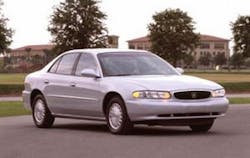Air conditioning service and repair can be profitable, with few comebacks, or it can be your worst nightmare.
Most technicians know that when a customer walks in and wants a tune-up, it’s time to ask a lot of questions. Customers assume their driveability issue will be solved by the magic of this service. It may be, but don’t count on it. The same issue occurs when they ask for “a shot” of refrigerant to fix their air conditioning. Start by getting a complete history and description of the problem. Listen carefully, don’t offer a quick estimate, and don’t ‘shoot from the hip -- it usually results in a shot to the foot.
Symptom: Vehicle has an A/C system with a variable displacement compressor using an orifice tube. The compressor runs and the radiator cooling fans work normally, but the duct outlet temperature is 15 to 20 degrees warmer than normal. There are no codes stored.
Diagnosis: 1) First, verify that the air temperature blend door has moved and remains in a full cold position. That separates a blend door problem from an A/C performance problem.
2) Check the compressor operation. Connect a set of pressure gauges and monitor low and high side pressures. It’s important to understand that this style compressor runs constantly, and automatically regulates the low side to about 30 to 40 psi at all times. This pressure allows the evaporator to work at peak efficiency. An undercharged system will show the same low side pressure as a fully charged system, only it won’t cool as well. High side pressures will also run lower. Also, a low refrigerant level will cause a lack of oil flow through the system, which results in compressor drag and accelerated wear. How do you spell “damage”?
3) If system contamination is not an issue, evacuate and recharge the system to the recommended refrigerant level. This is the only way to accurately test the system’s performance and continue the diagnostics.
4) Check temperatures and pressures. If the A/C system is low, check for and repair any leaks. Make your life easier and add the correct amount of approved dye to the system. It lasts about five years and makes leak detection a lot easier in the future.
Concerning oil, use the correct type and always follow the manufacturer’s instructions to fill to the correct level. Low oil level will cause compressor damage. Too much oil can, among other things, coat the inside of the evaporator and cause a major loss of cooling efficiency. Note that PAG oil is water soluble, so a drive in the rain or a trip through a car wash could eliminate the evidence of an oil/refrigerant leak.
If the system is contaminated, things become more complicated. Contamination often occurs from compressor breakdown, desiccant bag rupture or other problems. At a minimum, the accumulator, orifice tube, and other damaged parts should be replaced. All other parts should be completely flushed or replaced per the manufacturer’s recommendations.
Many condensers use tubes that have 18 ports each. These are small passageways which allow efficient heat transfer, but if plugged with debris, are next to impossible to flush clean.
If the compressor has burned up and scattered fragments through the system, the condenser is probably plugged, so remove it and install a new one. Experience has shown that flow testing a condenser off the vehicle is frequently inaccurate. A restricted condenser often appears to have good flow, but in fact, does not.
According to the Mobile Air Conditioning Society (MACS), a good way to check condenser efficiency is to operate a fully charged A/C system, and if the difference between the inlet and outlet temperature of the condenser exceeds 40 degrees Fahrenheit, replace it. If possible, use a contact thermometer for the test -- it’s more accurate than an infrared heat gun.
Moving on to the evaporator, the good news is that they typically do not plug and can be flushed. If the evaporator tubes (on the orifice tube system) are accessible, a quick estimate of system charge can be obtained by comparing the inlet and outlet evaporator tube temperatures.
Run the A/C on a hot day at the maximum level, with the windows open. The tubes should be within 5 degrees of each other; if more than 5 degrees, suspect a leak.
(For more information on Identifix, visit www.identifix.com.)



